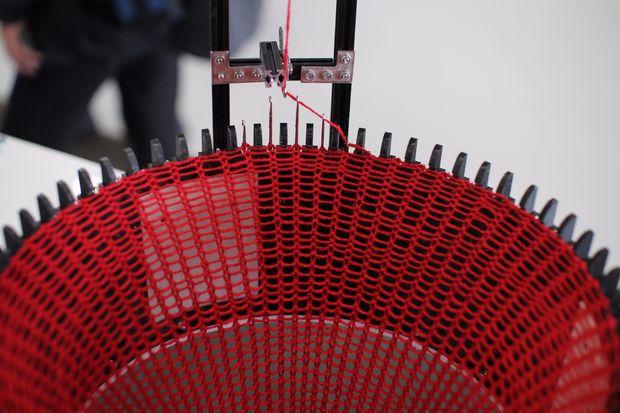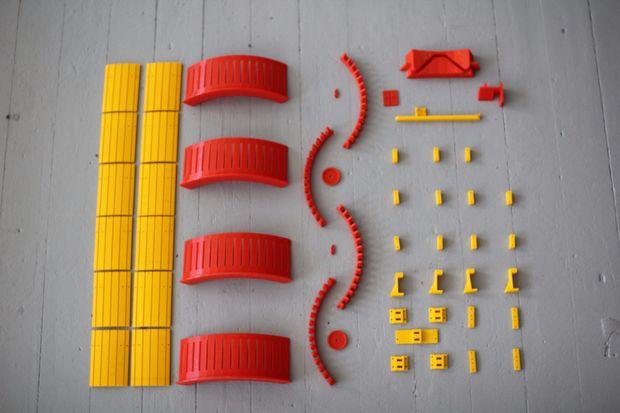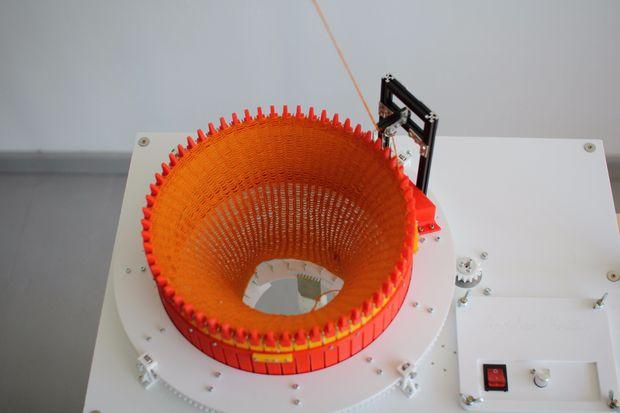Circular knitting, or knitting in the round, is a technique used to create seamless ‘tubes’ of knit material. Circular knitting can be done either on needles, double pointed or circular, or on a knitting machine. It is a very popular method for creating hats, socks, and sweaters among other knitted necessities. Knitting with the needles certainly has its appeal; it is somewhat meditative and soothing. The sound of the clicking needles, the movement of the yarn through your fingers, and watching a project build up, stitch by stitch, are all enjoyable parts of the process. However, using a knitting machine adds a super sized boost of speed that is also quite appealing.
 Inexpensive knitting machines for use by kids can be purchased for under $100, and more robust machines can range from several hundred to several thousand dollars. The process of knitting is reminiscent of that used in additive manufacturing, a filament (in this case yarn) is built up layer by layer into a 3 dimensional object…and the creation is only as good as the designer. In other words, it is a technology that doesn’t create on its own. The idea behind a circular knitting machine is that the building up of those layers can occur much more quickly, allowing the devoted knitter to spend more time designing, and/or prototyping their design.
Inexpensive knitting machines for use by kids can be purchased for under $100, and more robust machines can range from several hundred to several thousand dollars. The process of knitting is reminiscent of that used in additive manufacturing, a filament (in this case yarn) is built up layer by layer into a 3 dimensional object…and the creation is only as good as the designer. In other words, it is a technology that doesn’t create on its own. The idea behind a circular knitting machine is that the building up of those layers can occur much more quickly, allowing the devoted knitter to spend more time designing, and/or prototyping their design.
 The circular knitting machine and its capacity for rapid production made it an essential tool for the military during World War I when it was utilized to speed up the production of socks for the soldiers – a vital element of preventing trench foot. The appeal of the machine is fairly apparent and artists Mar Canet and Varvara Guljajeva wanted to contribute to its accessibility by creating their own open hardware machine. They called their creation the Circular Knitic. They explained:
The circular knitting machine and its capacity for rapid production made it an essential tool for the military during World War I when it was utilized to speed up the production of socks for the soldiers – a vital element of preventing trench foot. The appeal of the machine is fairly apparent and artists Mar Canet and Varvara Guljajeva wanted to contribute to its accessibility by creating their own open hardware machine. They called their creation the Circular Knitic. They explained:
“With the boom of digital fabrication technology, a 3D printer is gradually turning into a commodity that every creative studio has on their desk. At the same time, Fab Labs and makerspaces are a lot about hard-surfact object production while the first digital fabrication tool, an electronic knitting machine back in 1976, has been forgotten and discontinued. Hence, with this project, Circular Knitic, and our earlier one called Knitic, we aim to integrate textile fabrication to the makers’ culture.”
After all, it’s no coincidence that the root of the word ‘fabricate’ is ‘fabric.’
The project, which is detailed completely in an Instructables tutorial, requires laser cutting, 3D printing, basic woodworking, and comfort with electronics. There are 13 steps in total, to go from wish to completion, and a tutorial is included on how to cast on (the term used for starting the first stitch). The 3D print files are available for free download with the name of each file dictating how many copies need to be printed in order to create a complete machine. The creators add an emphatic note accentuating the need to print in high quality with a maximum 0.1 mm layer height.
There has been a hierarchy in making that has generally placed working with hard materials such as wood, plastic, glass, and metal at a higher level than working with soft goods. However, more makers are realizing the complexity and creativity required for the creation of textiles and other soft materials. As these have traditionally been conceived of in the West as feminine activities, they have all too often been ignored or denigrated as areas for creative expression. The creation of the Knitic helps to reintroduce the connection between all forms of making and makes a strong argument for the obvious relationship between 3D printing and knitting as methods of additive manufacturing.
What do you think of this clever creation? Discuss in the Knitic forum thread on 3DPB.com.
Subscribe to Our Email Newsletter
Stay up-to-date on all the latest news from the 3D printing industry and receive information and offers from third party vendors.
Print Services
Upload your 3D Models and get them printed quickly and efficiently.
You May Also Like
AM Can Evolve to Drive Entire Markets, and the Dental Industry is Proof
In an era of challenges to the additive manufacturing (AM) industry, mostly driven by the technology’s relatively high cost at a time when financing production equipment is more expensive, many...
AM Software Provider Dyndrite Forms Multi-Year Partnership with 3D Printed Propulsion Specialist Ursa Major
The right partnerships enable all parties involved to accentuate their strengths more effectively than would be possible if each partner was working alone. Digital manufacturing software provider Dyndrite, which specializes...
3D Printing News Briefs, July 23, 2025: ASTM Standard, Defense, Bioinks, & More
We’re starting with business news in today’s 3D Printing News Briefs, as Nikon AM Synergy has appointed a new CEO. Moving on, a proposed ASTM International standard will support 3D...
3D Printing News Briefs, July 19, 2025: Topology Optimization, Bike Saddle, & More
In this weekend’s 3D Printing News Briefs, Farsoon Technologies has reached a milestone of 150 large-format metal 3D printing systems being sold globally. Snapmaker unveiled a new 3D printer, and...































